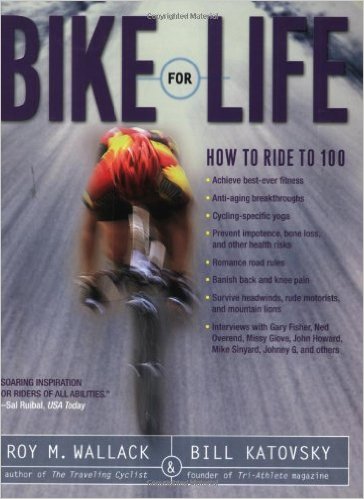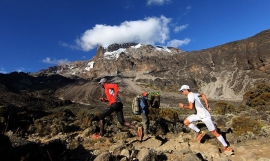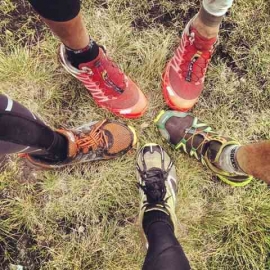Roy M. Wallack 出版书籍合集:
跑步书籍:
Barefoot Running Step by Step_Roy M. Wallack、Barefoot Ken Bob Saxton_2011
自行车书籍:
The Traveling Cyclist_Roy M. Wallack_1991
Bike for Life: How to Ride to 100_Roy M. Wallack_2005
Bike for Life: How to Ride to 100--and Beyond_Roy M. Wallack_2015
其他运动书籍:
Fire Your Gym! Simplified High-Intensity Workouts You Can Do At Home_Roy M. Wallack_2013
Bike for Life: How to Ride to 100
Cycling is one of the most popular and fastest growing activities in the nation—today more than 56 million recreational cyclists bike regularly in the United States. Now leading cycling journalists Roy M. Wallack and Bill Katovsky have assembled into one essential resource everything cyclists needs to know to bike for a lifetime. These experts present groundbreaking information on medical research, training techniques, nutrition, and technology and equipment trends that impact the sport at every level. They also assess the risks and provide informative solutions to many bike-related conditions that have been overlooked, sensationalized, or are just emerging, including impotence, osteoporosis, weakened immune systems, sore backs, depression, and even fractured relationships. Also featured are a dozen in-depth interviews with cycling legends, such as Gary Fisher, Ned Overend, John Howard, Missy Giove, Eddie B, and Marla Steb. This authoritative guide to getting the most out of your bike riding will appeal to cycling enthusiasts of all ages and abilities, and is a must-read for everyone who loves to get on a bike to compete, to keep fit and promote longevity, for fun, or simply to get from point A to point B.
Bike for Life: How to Ride to 100 Review
A great, funny page-turner that you simply don’t expect. -- MICHAEL FRANK, Deputy Editor, Bicycling and Mountain Bike
Bike for Life could be the most important book in your life. -- SAL RUIBAL, USA Today cycling writer
What a great book! -- STEVE BOEHMKE, Mountain Bike Hall of Fame inductee
About Bike for Life: How to Ride to 100 Author
ROY M. WALLACK has survived the Eco-Challenge, the Soviet Union by bike, and some of the world’s toughest two-wheel events. Author of The Traveling Cyclist and a former editor at Bicycle Guide, California Bicyclist, and Triathlete magazines, he is a sports-gear columnist for the Los Angeles Times and covers cycling, fitness, longevity, triathlon, and running for Bicycling, Men’s Journal, Playboy, Outside, Competitor, and VeloNews. He lives in Irvine, CA.
BLL KATOVSKY biked solo across America, finished the Hawaii Ironman twice, and founded Tri-Athlete magazine. In 2003, he co-authored Embedded: The Media at War in Iraq: An Oral History, which won Harvard’s Goldsmith Book Prize. He lives in Mill Valley, CA.
This is one the best book I have read about biking, and I actually still read it almost every day, checking out different aspects related to cycling - health issues, nutrition advises, and especially exercises and stretching before and after every ride. The book answers almost all of my questions, and considering the fact that I am a women and over 50, but still very ambitious to get better on the road, I find it so very useful - I could say necessary.
The only thing lacking in the book are photos or at least drawings in the chapters on exercises and yoga for cyclers. Maybe it is just me, but only reading the text-descriptions is not enough. Despite that, I would highly recommend the book to all cyclers, regardless of age. I learn enormously from it!
BUT there is a lot of good information. I think it was summed up by another reviewer who suggested there was too much fluff and too many longish interviews.
If there ever is a second edition to this book, and i think it'd be a great idea, might i suggest the following: more hard information about training (heart rate monitors and training levels receive very little if any mention), diagrams or pictures (imagine simply having yoga poses described to you with impercise language), and lastly, pide the interviews/inspiration stories of people who did inspirational rides into seperate sections.
to sum up, there is some good information and its presented in a congenial upbeat tone, but no illustrations and overlong interviews take away from its impact.
Bike for Life reads like a lifestyle magazine, categorized by topics designed to pique interest but follows up with depth reserved only for the New York Times or National Geographic. The authors know how to take a position without turning it into religion. Completing a Century ride on your 100th birthday appears within reach, but maybe not if your only activity is cycling.
It's likely that if you're a cyclist or triathlete you've already read both authors, Roy Wallack and Bill Katovsky. Both have been fixtures in the publishing world for years. In fact, Katovsky started Triathlete and Inside Triathlon, and Wallack was one of Triathlete's premier editors. You'll likely recognize each of their distinctive literary voices from chapter to chapter, and feel a pleasant familiarity not unlike the sense you get when James Earl Jones's voice shows up in a commercial. At once you feel at ease.
Simply, Bike for Life posits that cycling is an integral part of longevity but not a panacea. While aerobic fitness can be maximized riding, even into our golden years, other aspects of fitness and bicycling must be addressed. Strength training and flexibility fill in the gaps of cycling's physiological deficiencies. The right bike fit solves the hand, wrist,neck, back, foot and numb nethers issues plaguing many of us, which, if ignored either kill the enjoyment or take us off the bike altogether. And, cycling related benefits notwithstanding, this book is a user's manual for us all, cyclists or otherwise, because it details a cornucopia of secrets to long term health and fitness. It's like having all of those pertinent articles that we read and wanted to save (but never did) compiled and organized for our periodic reference.
Not only, entertaining interviews introduce us to legendary, mature riders who, whether setting records or just climbing into the saddle, embody an ideal, inspiring confidence in our own future, by their achievement, while their peers sidle up to canes and walkers. The authors' personal experiences aim their book squarely at you and me, recreational riders and age-group competitors who want to milk as much fulfillment and adventure as we can from our time turning the cranks. For what it's worth, I took the 34 mile, 10,000 ft. Haleakela volcano (on Maui, HI) climb challenge right off the pages of Bike for Life, essentially at Roy's behest. Now I have indelible imprints of a 4 hour ride from Mayberry to Mars that'll keep me company long as my memory remains - at least 'til my 100th birthday.
There's at least one typographical error. Spinal erectors - those muscles running the length of our vertebral column - are mis-described as spiny erectors. This bothered me - one who's found errors in the Webster's Third International Dictionary (really) - but probably not anyone else.
Bike for Life is a great read, a great reference tool and a great gift - I've given away a half dozen copies so far. As a triathlon coach, personal trainer and avid reader I recommend this book.




